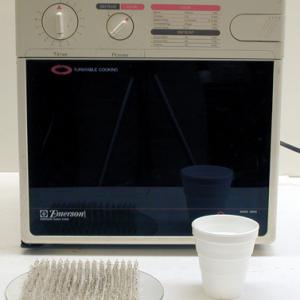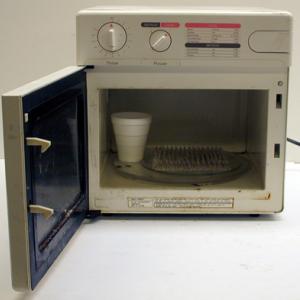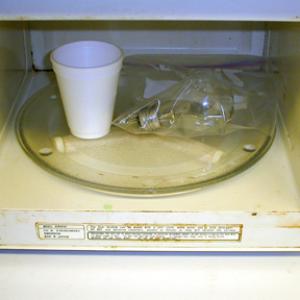College of Liberal Arts & Sciences
5N10.57 - Electromagnetic Radiation - Microwave Oven - Standing Waves
Place the neon light array and the Styrofoam cup with water into the microwave oven. Turn on the microwave and after several seconds wave patterns should be seen moving through the neon array.
NOTE: The Styrofoam cup with water must be placed in the oven with the array so that the field strength of the microwave does not build to dangerous levels that will burn out the magnetron.
NOTE: Do not leave this on for more than 15 seconds at a time or the hot glue on the array could come loose.
Eggs will sometimes give spectacular explosions in a microwave oven. Put either a fresh or hardboiled egg in a microwave safe container and place in the microwave. Heat for several minutes. Eggs that do not crack in the first minute will usually produce a spectacular rupture. About 1 in 10 eggs will do this.
Soap figures will usually expand while keeping their shape when heated in the microwave.
- James Lincoln, "An Improved Technique for Visualizing Microwave Wavelengths in Microwave Ovens", TPT, Vol. 57, #4, Apr. 2019, p. 271.
- Zachary H. Levine, "Science at Home: Measuring a Thermophysical Property of Water with a Microwave Oven", TPT, Vol. 56, #2, Feb. 2018, p. 107.
- Len Bugel, "Microwave Miscalculation", TPT, Vol. 40, #7, Oct. 2002, p. 387.
- Dan Maclsaac, "Author Response", TPT, Vol. 40, #7, Oct. 2002, p. 387.
- Heather Hosack, Nathan Marler, and Dan MacIsaac, "Microwave Mischief and Madness", TPT, Vol. 40, #5, May 2002, p. 264.
- D. A. Wardle, "Absorption of Microwaves in the Microwave Oven", TPT, Vol. 39, #4, Apr. 2001, p. 210.
- Martin Gardner, "The Electric Grape", TPT, Vol. 38, #8, Nov. 2000, p. 492.
- Jouni Viiri, "Temperature Distribution in a Microwave Oven", TPT, Vol. 36, #1, Jan. 1998, p. 48.
- C. Swartz, "A Marshmallow Paradox", TPT, Vol. 35, #6, Sept. 1997, p. 323.
- Robert H. Stauffer, Jr., "Finding the Speed of Light with Marshmallows - A Take Home Lab", TPT, Vol. 35, #4, Apr. 1997, p. 231.
- Fred Bucheit, "Hot Spots in the Morning", TPT, Vol. 32, #4, Apr. 1994, p. 199.
- Barbara S. Andereck, "Microwave Hot Spots",TPT, Vol. 28, #9, Dec. 1990, p. 580.
- Ron Fritz, "Calibration and Efficiency of Microwave Ovens", TPT, Vol. 28, #8, Nov. 1990, p. 564.
- Alistair Steyn-Ross and Alister Riddell, "Standing Waves in a Microwave Oven", TPT, Vol. 28, #7, Oct. 1990, p. 474.
- Tibor S. Laszlo, "Industrial Applications of Microwaves", TPT, Vol. 18, #8, Nov. 1980, p. 570.
- Benjamin K. Barnes, Habilou Ouro-Koura, Justin Derickson, Samuel Lebarty, Jesudara Omidokun, Nathan Bane, Othman Suleiman, Eguono Omagamre, Mahdi J. Fotouhi, Ayobami Ogunmolasuyi, Arturo Dominguez, Larry Gonick, Kausik S. Das, "Plasma Generation by Household Microwave Oven for Surface Midification and Other Emerging Application", AJP, Vol. 89, #4, April 2021, p. 372.
- S. Kamol, P. Limsuwan, and W. Onreabroy, "Three-Dimensional Standing Waves in a Microwave Oven", AJP, Vol. 78, #5, May, 2010, p. 492.
- Craig F. Bohren, "Answer to Question #46", AJP, Vol. 65, #1, Jan. 1997, p. 12.
- Clifford Swartz, "Questions #46, How Does The Microwave Oven Really Work?", AJP, Vol. 64, #7, July 1996, p. 839.
- W. P. Lonc, "Heat Experiment With A Microwave Oven", AJP, Vol. 57, #1, Jan. 1989, p. 51.
- Aaron Slepkov, "Fruit Photonics And The Shape Of Water", Physics Today, Vol. 73, # 6, June 2020, p. 62.
- "Back Scatter: Grape balls of fire", Physics Today, Vol.70, #10, Oct. 2017, p. 96.
- "This Day in Physics History: October 8, 1945: First Patent for the Microwave", APS News, Vol. 24, #9, Oct. 2015, p. 2, 5.
- Jacqueline Detwiler, "Scientists Finally Figured Out Why Grapes Spark in the Microwave", Popular Mechanics, Dec. 2019, p. 30.
- Dan Pashman, "The Smart Man's Guide to Microwaving", Popular Mechanics, May 2015, p. 32.
- Rick Beyer, "Cooking with Radar", The Greatest Science Stories Never Told, p. 152.
- Rick Beyer, "Cooking With Radar", Reader's Digest Special Edition - "The Greatest Stories Never Told", ISBN 978-0-7621-0554-0.
- Jearl Walker, "4.48, Heating in a Microwave Oven", The Flying Circus of Physics Ed. 2, p. 197.
- Michael Vollmer, "Physics of the Microwave Oven", Physics Education, Vol. 39, #1, Jan. 2004, p. 74.
- Kerry Parker and Michael Vollmer, "Bad Food and Good Physics: The Development of Domestic Microwave Cookery", Physics Education, Vol. 39, #1, Jan. 2004, p. 82.
- Michael Vollmer, Klaus-Peter Mollmann and Detlef Karstadt, "More Experiments with Microwave Ovens", Physics Education, 39, #4, p. 346.
- Brain Jones and Matt Fackelman, Don't Forget the Duct Tape! "Don't Try This At Home: How a Microwave Works", p. 41.
- Curt Suplee, "Turning up the Heat", Everyday Science Explained, National Geographic, p. 66 - 67.
Disclaimer: These demonstrations are provided only for illustrative use by persons affiliated with The University of Iowa and only under the direction of a trained instructor or physicist. The University of Iowa is not responsible for demonstrations performed by those using their own equipment or who choose to use this reference material for their own purpose. The demonstrations included here are within the public domain and can be found in materials contained in libraries, bookstores, and through electronic sources. Performing all or any portion of any of these demonstrations, with or without revisions not depicted here entails inherent risks. These risks include, without limitation, bodily injury (and possibly death), including risks to health that may be temporary or permanent and that may exacerbate a pre-existing medical condition; and property loss or damage. Anyone performing any part of these demonstrations, even with revisions, knowingly and voluntarily assumes all risks associated with them.



